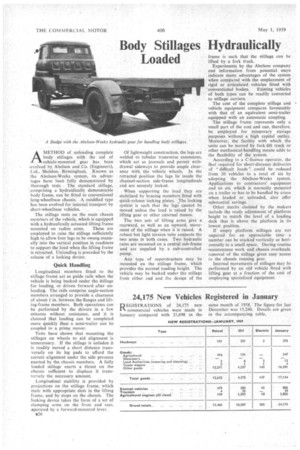Body Stillages Hydraulically Loaded
Page 60

If you've noticed an error in this article please click here to report it so we can fix it.
AMETHOD of unloading complete body stillages with the aid of -t.-vehicle-mounted gear has, been -evolved by Abelson and Co. (Engineers), .Ltd., Sheldon, Birmingham. Known as • the Abelson-Weeks . system, its advantages have been fully demonstrated by thorough. tests. The standard stillage, comprising a hydraulically demountable body frame, can be fitted to conventional long-wheelbase chassis. A modified type has been evolved for internal transport by short-wheelbase vehicles.
The stillage rests on .the main chassis members of the vehicle, which is equipped with a hydraulically actuated lifting frame
mounted on radius arms. These are employed to raise the stillage sufficiently high to allow four legs to be swung manually into the vertical position in readiness to support the load when the lifting frame is retracted. Unloading is preceded by the 'release of a locking device.
Quick Handling
Longitudinal rriernbers fitted to the stillage frame act as guide rails when the vehicle is being backed under.the for loading, or driven forward after unloading. The rails comprise angle-section members arranged to provide a clearance of about 1 in. between the flanges and lifting-frame members. Both operations can be performed by the drivers in a few minutes without assistance, and it is claimed that loading can be completed more quickly than a semi-trailer can be coupled to a prime mover.
Tests have shown that mounting the stillages on wheels to aid alignment is unnecessary. If the stillage is unladen it is readily moved a short distance transversely on its leg pads to afford the correct alignment under the side pressure exerted by the chassis members. A fully loaded stillage exerts a thrust on the chassis sufficient to displace it transversely the necessary amount.
Longitudinal stability is provided by projections on the stillage frame, which mate with appropriate slots in the lifting frame, and by stops on the chassis. The locking device takes the form of a set of clamping arms on the front and rear, operated by a forward-mounted lever.
B26
Of lightweight construction, the legs are welded to tubular transverse extensions, which act as journals and permit withdrawal sideways to provide ample clearance with the. vehicle .wheels. In the retracted Position the legs lee inside the channel-section side-frame longitudinals and are securely locked.
When supporting the load they are stabilized by bracing members fitted with quick-release locking plates. The locking system is such that the legs cannot be Moved unless the load is raised by the lifting gear or other external means.
The two sets of lifting arms give a rearward, as' well as an upward, movement of the stillage when it is raised. A robust but light torsion tube corinects the two arms in both cases. Two hydraulic rams are mounted on a central sub-frame and are supplied by a cab-controlled pump.
Any type of superstructure may be mounted on the stillage frame, 'which provides the normal loading height. The vehicle may he backed under the stillage from either end and the design of the
frame is such that the stillage. can be lifted by a fork truck. • Experiments by the Abelson company and information from potential users indicate many advantages of the system when compared with the employment of rigid or articulated vehicles fitted with conventional bodies. Existing Vehicles of both types can be readily converted to stillage carriers.
The cost of the complete stillage and vehicle equipment compares favourably with that of an equivalent semi-trailer equipped with an automatic coupling.
The stillage frame represents only a small part of the cost and can, therefore, be employed for temporary storage purposes without a high capital outlay. Moreover, the facility with which the units can be moved by fork-lift truck or other mechanical-handling means adds to the flexibility of the system.
According to a C-licence operator, the fleet required for short-distance deliveries of "difficult loads" could be reduced from 20 vehicles to a total of six by adopting the Abelson-Weeks system. Applications to contractors' equipment and so on, which is normally mounted on a trailer or has to be handled by crane when loaded or unloaded, also offer substantial savings.
Other merits claimed by the makers include the ready adjustment of platform height to match the level of a loading deck that is above the platform in its lowest position.
If empty platform stillages are not required for an appreciable time a number can be stacked vertically or horizontally in a small space. During routine maintenance work and chassis overhauls, removal of the stillage gives easy access to the chassis running gear.
Internal movements of stillages may be performed by an old vehicle fitted with lifting gear at a fraction of the cost of employing specialized equipment.




































































































